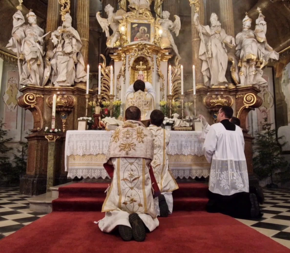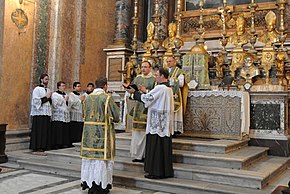Our website is made possible by displaying online advertisements to our visitors.
Please consider supporting us by disabling your ad blocker.
Solemn Mass


Solemn Mass (Latin: missa solemnis) is the full ceremonial form of a Mass, predominantly associated with the Tridentine Mass where it is celebrated by a priest with a deacon and a subdeacon,[1] requiring most of the parts of the Mass to be sung, and the use of incense. It is also called High Mass or Solemn High Mass.[1]
These terms distinguish it from a Low Mass and Missa cantata. The parts assigned to the deacon and subdeacon are often performed by priests in vestments proper to those roles. A Solemn Mass celebrated by a bishop has its own particular ceremonies and is referred to as a Solemn Pontifical Mass. Within the Roman Rite, the history of the Solemn Mass has been traced to the 7th century in the Gregorian Sacramentary and Ordo Romanus Primus, followed by several centuries of adapting these pontifical liturgies. Eventually, the proliferation of multiple parish churches within the same cities saw these liturgies further adapted so that the average priest could celebrate them. By the 13th century, those Masses with ceremonial more closely following that of the pontifical liturgies were identified as "Solemn" or "High Masses" in contrast with simpler "Low Masses".[2] Since the promulgation of the 1969 Roman Missal, much of the Solemn Mass's ceremonial has fallen into obsolescence and disuse.[2]
- ^ a b Cite error: The named reference
CathEncwas invoked but never defined (see the help page). - ^ a b Crichton, J.D. (1986). "Mass, High". In Davies, J.G. (ed.). The Westminster Dictionary of Liturgy and Worship. Philadelphia: Westminster Press. p. 365. ISBN 0-664-21270-0.
Previous Page Next Page


